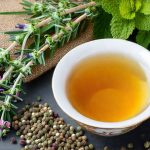Lower abdominal tension is an incredibly common experience, often stemming from stress, digestive issues, hormonal fluctuations, or simply everyday life. It manifests in various ways – cramping, bloating, a feeling of tightness, even radiating discomfort into the lower back. While many seek quick fixes, incorporating gentle herbal teas can be a remarkably effective and soothing approach to easing this tension. This isn’t about masking symptoms; it’s about offering your body support through natural ingredients known for their calming and restorative properties. The key is understanding how different herbs interact with the digestive system and nervous system, allowing you to create simple tea combinations that address the root causes of discomfort rather than just temporarily suppressing them.
The beauty of using teas lies in their gentle nature. Unlike some medications or drastic dietary changes, herbal infusions are often well-tolerated and can be easily integrated into a daily routine. They offer a moment of self-care – a pause to breathe deeply and nurture your body from within. Furthermore, the act of preparing tea itself is inherently calming; the ritual of heating water, steeping herbs, and savoring the aroma promotes mindfulness and reduces overall stress levels which can significantly contribute to lower abdominal tension. Remember that individual responses vary, so paying attention to how your body reacts to different teas is crucial for finding what works best for you.
Soothing Herbal Allies: Core Tea Ingredients
Certain herbs have a long history of use in alleviating digestive discomfort and promoting relaxation. Peppermint is perhaps the most well-known, lauded for its ability to ease bloating and gas. It contains menthol, which has antispasmodic properties that can help relax the muscles of the digestive tract. Chamomile, on the other hand, excels at calming nervous tension, which often exacerbates abdominal discomfort. Its gentle sedative effects can reduce stress hormones and promote a sense of overall wellbeing. Ginger is another powerhouse, offering anti-inflammatory benefits and aiding digestion. It’s particularly helpful for nausea or feelings of fullness. If you’re looking to support your kidney health alongside these teas, consider exploring daily tea habits that support kidney cleansing.
Beyond these staples, consider incorporating fennel seeds – known to reduce bloating and gas, and dandelion root – which supports liver function and healthy digestion. Licorice root can be beneficial in balancing hormones (though caution is advised if you have high blood pressure), and lemon balm offers calming effects similar to chamomile, but with a slightly more citrusy flavor. Combining these herbs strategically allows you to address multiple facets of lower abdominal tension simultaneously. For instance, incorporating supportive dietary choices like foods that ease tension after long sitting periods can complement the benefits of these teas.
The effectiveness of these teas isn’t just anecdotal. Many studies have shown the positive impact of these herbs on digestive health and stress reduction. However, it’s vital to source high-quality, organic herbs whenever possible to ensure you’re receiving the full benefits without unwanted additives or contaminants. Always check for potential allergies or interactions with medications before introducing new herbal remedies into your routine.
Tea Blends for Specific Concerns
Let’s move beyond individual ingredients and explore some practical tea combinations tailored to different types of lower abdominal tension. The first, a “Digestive Reset” blend, is ideal for bloating, gas, and general digestive sluggishness. It combines:
– 1 teaspoon peppermint leaves
– ½ teaspoon fennel seeds
– ¼ teaspoon ginger root (freshly grated or dried)
This blend works by stimulating digestion, reducing inflammation, and relieving muscle spasms in the gut. To prepare it, steep a teaspoon of the mixture in hot water for 5-7 minutes.
Next is a “Stress Relief” blend, designed to address tension stemming from anxiety or stress. This incorporates:
– 1 teaspoon chamomile flowers
– ½ teaspoon lemon balm leaves
– ¼ teaspoon lavender buds (use sparingly – it’s potent!)
This combination soothes the nervous system, reduces cortisol levels, and promotes relaxation. Steeping this blend for a longer period – up to 10 minutes – helps extract more of the calming compounds. To further support stress reduction, consider integrating daily microbreaks that reduce lower abdominal stress into your routine.
Finally, consider a “Hormonal Balance” blend (use with caution and research if you have existing health conditions). This utilizes:
– 1 teaspoon chamomile flowers
– ½ teaspoon licorice root (avoid if you have high blood pressure)
– ¼ teaspoon fennel seeds
This blend can help regulate hormonal fluctuations that sometimes contribute to lower abdominal tension, particularly during menstruation. It’s best consumed in cycles, aligning with your menstrual cycle if applicable.
Brewing and Enjoying Your Tea
The way you brew your tea significantly impacts its flavor and therapeutic benefits. Avoid using boiling water for delicate herbs like chamomile; instead, aim for around 175-185°F (80-85°C). This preserves the volatile oils that contribute to their healing properties. A good rule of thumb is to let boiled water cool for a few minutes before pouring it over your herbs. Use filtered water whenever possible – tap water can contain chlorine and other minerals that affect the taste.
To maximize extraction, cover your tea while steeping; this prevents the volatile oils from escaping. The steeping time varies depending on the herbs used. Generally, 5-10 minutes is sufficient for most blends. Experiment with different steeping times to find what suits your preferences. Don’t be afraid to adjust the proportions of herbs to create a blend that you truly enjoy. Pairing this mindful tea ritual with soft touch awareness for lower abdominal release can further enhance relaxation.
Beyond the brewing process itself, creating a relaxing tea ritual can amplify its benefits. Find a quiet space where you won’t be disturbed. Light a candle, play soft music, and take a few deep breaths before sipping your tea slowly and mindfully. Focus on the aroma, the warmth spreading through your body, and the calming sensations it evokes. This mindful approach transforms tea drinking from a simple beverage into a powerful act of self-care – one that can profoundly impact your overall wellbeing and help alleviate lower abdominal tension naturally. Remember to also consider incorporating movement pauses that calm pelvic tension throughout the day for holistic support, and don’t underestimate the impact of simple adjustments like clothing adjustments that ease lower abdomen discomfort.





















